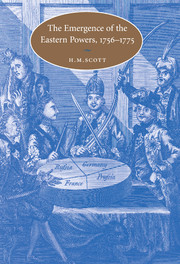Book contents
- Frontmatter
- Contents
- List of maps and genealogical table
- Acknowledgements
- A note on dates and place names
- List of abbreviations
- Introduction: the eighteenth-century European states system and its transformations
- 1 The rise of the eastern powers
- 2 The Seven Years War and the European states system
- 3 The domestic legacies of the Seven Years War
- 4 The stabilisation of Europe, 1763–1766
- 5 Diplomacy and the eastern powers
- 6 From peace to war, 1766–1768
- 7 The partition of Europe, 1768–1772
- 8 The advance of Russia, 1772–1775
- Conclusion: Russia and the emergence of the eastern powers
- Bibliography
- Index
- CAMBRIDGE STUDIES IN EARLY MODERN HISTORY
Conclusion: Russia and the emergence of the eastern powers
Published online by Cambridge University Press: 16 July 2009
- Frontmatter
- Contents
- List of maps and genealogical table
- Acknowledgements
- A note on dates and place names
- List of abbreviations
- Introduction: the eighteenth-century European states system and its transformations
- 1 The rise of the eastern powers
- 2 The Seven Years War and the European states system
- 3 The domestic legacies of the Seven Years War
- 4 The stabilisation of Europe, 1763–1766
- 5 Diplomacy and the eastern powers
- 6 From peace to war, 1766–1768
- 7 The partition of Europe, 1768–1772
- 8 The advance of Russia, 1772–1775
- Conclusion: Russia and the emergence of the eastern powers
- Bibliography
- Index
- CAMBRIDGE STUDIES IN EARLY MODERN HISTORY
Summary
Russia's territorial gains in 1772–5 were striking and, in the longer perspective, proved decisive. They consolidated her leading position, created by her armies during the Seven Years War but not immediately exploited. It was further strengthened by a restoration of Russian control over Poland, where Stackelberg ruled as viceroy during the 1770s and 1780s. St Petersburg's Polish acquisitions and the annexations from the Ottoman empire were, however, rather different in nature. The first partition did not establish a new way for the great powers to expand their territories, with the exception of Austria's cynical annexation of the Bukovina and Frederick's simultaneous and ultimately unsuccessful efforts to seize Danzig. In keeping both with established ideas about the ‘balance of power’ and the political situation in 1771–2, Russian gains from Poland had been matched by approximately equal shares for the other eastern powers. This expressed the doctrine that no single state could be permitted to make unilateral acquisitions, since thiswould undermine the equilibrium which, in theory at least, existed between the great powers. This idea was to underpin the second and third partitions (1793; 1795) which were to excise Poland from the map of Europe, without a war being fought by the competing powers. Together, the partitions were to move Russia's European frontier over 250 miles westwards, a process which began in 1772 and would enhance her ability to intervene in central Europe, while underlining her new political importance.
The annexations from the Ottoman empire were even more significant at the time.
- Type
- Chapter
- Information
- The Emergence of the Eastern Powers, 1756–1775 , pp. 249 - 258Publisher: Cambridge University PressPrint publication year: 2001



